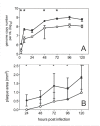Growth kinetics and transmission potential of existing and emerging field strains of infectious laryngotracheitis virus
- PMID: 25785629
- PMCID: PMC4365042
- DOI: 10.1371/journal.pone.0120282
Growth kinetics and transmission potential of existing and emerging field strains of infectious laryngotracheitis virus
Abstract
Attenuated live infectious laryngotracheitis virus (ILTV) vaccines are widely used in the poultry industry to control outbreaks of disease. Natural recombination between commercial ILTV vaccines has resulted in virulent recombinant viruses that cause severe disease, and that have now emerged as the dominant field strains in important poultry producing regions in Australia. Genotype analysis using PCR-restriction fragment length polymorphism has shown one recombinant virus (class 9) has largely replaced the previously dominant class 2 field strain. To examine potential reasons for this displacement we compared the growth kinetics and transmission potential of class 2 and class 9 viruses. The class 9 ILTV grew to higher titres in cell culture and embryonated eggs, but no differences were observed in entry kinetics or egress into the allantoic fluid from the chorioallantoic membrane. In vivo studies showed that birds inoculated with class 9 ILTV had more severe tracheal pathology and greater weight loss than those inoculated with the class 2 virus. Consistent with the predominance of class 9 field strains, birds inoculated with 10(2) or 10(3) plaque forming units of class 9 ILTV consistently transmitted virus to in-contact birds, whereas this could only be seen in birds inoculated with 10(4) PFU of the class 2 virus. Taken together, the improved growth kinetics and transmission potential of the class 9 virus is consistent with improved fitness of the recombinant virus over the previously dominant field strain.
Conflict of interest statement
Figures




Similar articles
-
Genetic Diversity of Infectious Laryngotracheitis Virus during In Vivo Coinfection Parallels Viral Replication and Arises from Recombination Hot Spots within the Genome.Appl Environ Microbiol. 2017 Nov 16;83(23):e01532-17. doi: 10.1128/AEM.01532-17. Print 2017 Dec 1. Appl Environ Microbiol. 2017. PMID: 28939604 Free PMC article.
-
Single Nucleotide Polymorphism Genotyping Analysis Shows That Vaccination Can Limit the Number and Diversity of Recombinant Progeny of Infectious Laryngotracheitis Viruses from the United States.Appl Environ Microbiol. 2018 Nov 15;84(23):e01822-18. doi: 10.1128/AEM.01822-18. Print 2018 Dec 1. Appl Environ Microbiol. 2018. PMID: 30242009 Free PMC article.
-
Replication-independent reduction in the number and diversity of recombinant progeny viruses in chickens vaccinated with an attenuated infectious laryngotracheitis vaccine.Vaccine. 2018 Sep 11;36(38):5709-5716. doi: 10.1016/j.vaccine.2018.08.012. Epub 2018 Aug 10. Vaccine. 2018. PMID: 30104116
-
The route of inoculation dictates the replication patterns of the infectious laryngotracheitis virus (ILTV) pathogenic strain and chicken embryo origin (CEO) vaccine.Avian Pathol. 2017 Dec;46(6):585-593. doi: 10.1080/03079457.2017.1331029. Epub 2017 Jun 19. Avian Pathol. 2017. PMID: 28532159 Review.
-
Molecular biology of avian infectious laryngotracheitis virus.Vet Res. 2007 Mar-Apr;38(2):261-79. doi: 10.1051/vetres:200657. Epub 2007 Feb 13. Vet Res. 2007. PMID: 17296156 Review.
Cited by
-
Reconstitution and Mutagenesis of Avian Infectious Laryngotracheitis Virus from Cosmid and Yeast Centromeric Plasmid Clones.J Virol. 2023 Apr 27;97(4):e0140622. doi: 10.1128/jvi.01406-22. Epub 2023 Apr 6. J Virol. 2023. PMID: 37022163 Free PMC article.
-
Genomic recombination between infectious laryngotracheitis vaccine strains occurs under a broad range of infection conditions in vitro and in ovo.PLoS One. 2020 Mar 2;15(3):e0229082. doi: 10.1371/journal.pone.0229082. eCollection 2020. PLoS One. 2020. PMID: 32119681 Free PMC article.
-
Attenuated infectious laryngotracheitis virus vaccines differ in their capacity to establish latency in the trigeminal ganglia of specific pathogen free chickens following eye drop inoculation.PLoS One. 2019 Mar 28;14(3):e0213866. doi: 10.1371/journal.pone.0213866. eCollection 2019. PLoS One. 2019. PMID: 30921344 Free PMC article.
-
Evaluation of Recombinant Herpesvirus of Turkey Laryngotracheitis (rHVT-LT) Vaccine against Genotype VI Canadian Wild-Type Infectious Laryngotracheitis Virus (ILTV) Infection.Vaccines (Basel). 2021 Dec 3;9(12):1425. doi: 10.3390/vaccines9121425. Vaccines (Basel). 2021. PMID: 34960175 Free PMC article.
-
Protection Induced in Broiler Chickens following Drinking-Water Delivery of Live Infectious Laryngotracheitis Vaccines against Subsequent Challenge with Recombinant Field Virus.PLoS One. 2015 Sep 14;10(9):e0137719. doi: 10.1371/journal.pone.0137719. eCollection 2015. PLoS One. 2015. PMID: 26366738 Free PMC article.
References
-
- Gimeno IM, Cortes AL, Guy JS, Turpin E, Williams C. Replication of recombinant herpesvirus of turkey expressing genes of infectious laryngotracheitis virus in specific pathogen free and broiler chickens following in ovo and subcutaneous vaccination. Avian Pathol 2011;40: 395–403. 10.1080/03079457.2011.588196 - DOI - PubMed
-
- Kirkpatrick NC, Mahmoudian A, O'Rourke D, Noormohammadi AH. Differentiation of infectious laryngotracheitis virus isolates by restriction fragment length polymorphic analysis of polymerase chain reaction products amplified from multiple genes. Avian Dis 2006;50: 28–34. - PubMed
Publication types
MeSH terms
LinkOut - more resources
Full Text Sources
Other Literature Sources

